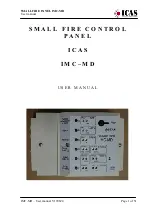
5
Pow-R-Line X Retrofit Panelboards
Pow-R-Line X RetRofit PaneLboaRds
MN014011EN January 2020 eatoncanada.ca
Pre-Energizing Procedures and Inspection
Before energizing any panelboard, perform a comprehensive
inspection to make certain that the panelboard is ready to
be energized. This includes the following steps:
1. Verify that the panelboard is not energized.
2. Visually inspect the panelboard and remove all
foreign materials, such as, tools, scraps of wire and
other debris from all panelboard sections.
3. Remove and discard all packing materials and
temporary shipping braces from the panelboard.
4. Any accumulation of dust and dirt should be
removed with a vacuum cleaner. Use a lint-free cloth
to remove dust and dirt on other surfaces. Never
use compressed air as this may blow contaminants
into electrical and/or electronic components. Never
use solvents or other chemicals to clean surfaces or
components.
5. Visually inspect all ventilation points to ensure that
there is no blockage or debris. Remove all debris, if
present.
6. Verify all field wire connections have the proper
torque per instructions on the panelboard and on
components.
7. All factory connections are made utilizing calibrated
power tools. However, vibrations do occur in
transit and handling. Verify factory connections
by checking at least 10% of the total factory
connections for tightness. If this spot check
reveals loose connections, proceed to check all
factory connections. These connections include bus
hardware connections, circuit breaker terminals, and
other connections, including the incoming terminals.
8. Visually inspect panelboard insulators, bus bar
and conductors for damage. DO NOT ENERGIZE IF
DAMAGE IS FOUND. Contact Eaton.
Circuit Breakers
Circuit breakers are typically shipped in either the open
(OFF) or “tripped” position. Manually close, and then open
these devices to ensure they are functioning properly. At
the completion of this process, be sure that the circuit
breaker is in the “OFF” or “tripped” position. Inspect circuit
breakers for any visible damage.
If damage is found, DO NOT ENERGIZE the panelboard.
Contact Eaton.
Overcurrent Devices with Ground Fault Protection
This panelboard may contain overcurrent devices with
Ground Fault Protection (GFP). The National Electrical Code
may require ground fault protection for this installation.
Other GFP applications may be used including multi-level
ground fault protection. Refer to the panelboard drawings
and electrical construction drawings for usage and
placement within the panelboard.
Ground fault protection may be installed integral to
overcurrent device(s) or as a separate system. Separate
systems typically are connected to a shunt tripping
mechanism on an overcurrent device.
Visibly inspect connections on GFP systems, neutral
sensors and ground connections. Refer to manufacturer’s
instructions for details.
The National Electrical Code, Article 230-95 requires that
any GFP systems must be performance tested when first
installed. Conduct tests in accordance with the approved
instructions provided with the equipment. A written test
report must be available for the Authority Having Jurisdiction
(AHJ). Refer to the National Electrical Code for specific
requirement or contact Eaton. Field-testing of ground fault
protection must follow instructions provided with each
GFP device. Due to the varied types of GFP systems,
testing instructions can vary from device to device. Refer
to the specific testing instructions for each device. Refer to
instruction leaflets that are shipped with each panelboard
containing GFP or contact Eaton.
Preparing Panelboard for Insulation/Megger
Testing
Devices Installed with Control Power Fusing
Devices, which require control power fusing, can be easily
damaged beyond repair if not disconnected during the
testing phase. These devices include, but are not limited
to, customer metering equipment, electronic breaker trip
units, motor operators and communication equipment. Prior
to testing the panelboard, turn off all control power devices
in the panelboard to prevent damage to components. The
control power may be turned off by utilizing the control
power switch or by removing the fuses. Components that
use power supplies include customer metering and certain
breaker accessories and these must be isolated before
testing.
WARNING
TO PREVENT DAMAGE TO GROUND FAULT CONTROL
CIRCUITS, METERING CIRCUITS, TRANSIENT VOLTAGE
SURGE PROTECTION (TVSS) OR OTHER CONTROL
CIRCUITS, WHEN
MEGGERING PANELBOARD, ISOLATE CIRCUITS FROM
PANELBOARD SYSTEM BEFORE BEGINNING THE MEGGER
OPERATION. BE SURE TO RECONNECT THOSE CIRCUITS
AFTER MEGGER TESTS ARE COMPLETED.
NOTEe: SOME GROUND FAULT CIRCUITS MAY NOT BE
FUSED, THEREFORE ISOLATION OF THOSE CIRCUITS
REQUIRES DISCONNECTING WIRING FROM BUS BARS.
Summary of Contents for P1RX 240Vac Max
Page 2: ......


































